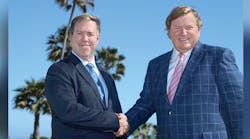NTTC gathered an esteemed group of industry executives for a carrier panel focused on “Optimizing Fleet Profitability Through Technology” during National Tank Truck Carriers’ 68th Annual Conference in San Diego, California.
The panel: Bernie Gorski, vice-president of Gorski Bulk Transport; Jeff Moe, president of Solar Transport; and Steve Rush, president of Carbon Express. The panel was moderated by Ryan Streblow, NTTC senior vice-president of sales and marketing.
Over the course of 50 minutes, they discussed the growing role played by technology in their operations. They also addressed some of the technology challenges they have faced.
Q: Could you explain your individual overall vision for acceptance of technology?
Rush: Our first big move was to electronic driver logs. That was a real eye-opener for us. As we’ve gone along, we’ve added collision warning systems. We don’t have the lane-change monitoring. However, I’ve heard some great stuff about that from people I’ve met this week, so I’m going to look at that. One of the things is, we’ve actually been able to hire a lot of 20-year-olds in the last three years. They want this technology. They want technology and they accept it.
Moe: From a strategic vision standpoint, we added it to our strategic plan about eight years ago. So that’s in addition to safety programs, which are obviously still #1 in our industry, which is good. We’ve decided that one of the advantages we were going to create and sell was a technology package that provided data and analytics to our customers. It’s wrapped onto almost everything we do. We started onboard recording devices in 2005, and electronic driver logs shortly after that. I have just as much passion about electronic logging as Steve does. It’s really wrapped technology into every other aspect of what we’re trying to build as a company, whether it’s safety programs or customer service, recruiting, retention. It’s really the base of our overall package.
Gorski: We’ve endorsed technology everywhere it’s been available, going back many years. We thought that the higher use of the available technology makes us more efficient, makes us safer, and makes us more profitable. And so every time there’s a new technology, we go calculate the ROI (return on investment) and see how it’s going to fit and how it’s going to benefit us, how it’s going to give us better customer service, and how it’s going to be better for the drivers, because they’re #1 in our industry. When they’re happy, we’re happy.
Q: Bernie, can you share the most impactful technology you’ve implemented to increase your profitability and safety?
Gorski: When the wireless technology was available for trucks, that was significant. We endorsed TMW. At the beginning of TMW, it was an extremely awkward, cumbersome program to use because of the type of database. Once we got it going, TMW has improved their systems to the point where we are comfortable with using all the reports. The onboard logs, when we started looking at that, it was about 2010. We had all of the resistance from the drivers, and it’s nice to say at that time, we only lost one driver out of 70 because he was too stubborn. And since then, it’s been a benefit to us. One of the drivers came out to me the other day at a safety meeting and said, ‘This is the best thing ever. It saves me a half hour a day. At the end of the year, it gives me three more weeks of opportunity to work and earn money.’ I thought that was phenomenal. So we’ve used that quote in our other areas. We like the driver acceptance and we enjoy all of the technology available to us.
Moe: I think probably our biggest win in the last few years is, we bought inventory services a number of years ago and have about 75% of the customer base that we do inventories for. We’re over 90% fuel and 90% convenience stores, so that’s a lot of the ability to sell our value. We obviously haul loads like many other carriers do, but we partner with the customer base to hook up to their ATGs and keep inventories for them. We’ve even gone as far from a package standpoint to help some of customers update their ATGs to get compliant with the technology package we have. Not only does it add a lot of value in the process and make it simpler to calculate forecast loads, but at the end of the day, it locks the customer in for potentially longer than they would be. When you’ve invested from a technology platform with that, you’re managing an aspect of their business they don’t have to. It’s been a huge value-added for us.
Q: Steve, on the topic of ELDs—which obviously you’re very passionate about—can you walk the group through some of the change management you’ve guys have run through at an executive level and how it was implemented and accepted in your organization?
Rush: We took a long time. We took two years of really making drivers toe the line and do it right. A lot of them really didn’t have a log. I remember as a driver, there would be many nights you would pull into a truck stop for a cup of coffee, and there would be four or five guys fixing their log. So putting guys on the electronic log slowly was really the best way to do that. I can tell you, and I meant to say this before, that we were 34-35 trucks when we went to electronic logs, and today we’re 47 company-owned. So I got better as an owner. I’ve been forced to understand my cost advantage and make sure that I was getting correct money back from shippers and receivers. So it’s unbelievable. I still don’t think the government knows how important this is. They can’t police it. It’s going to be difficult because there are people who have electronic logs and still cheat. That has to be corrected. This time, however, the cheat is no longer on the driver.
Moe: The playing field is not fair and hasn’t been for a long time. We had a significant pushback from a lot of our older drivers when we first announced putting electronic logging in. We lost two, and both were over 65, so we fundamentally, very quickly, had a pretty solid adoption. Now, when a driver’s truck has to go in for maintenance, he’s in a rental vehicle, which does not have electronic logging. We’re actually on the opposite side of it now. If we ever tried to take it away, we’d have significantly more people quit than we did when we put it in place.
PI would say that’s a huge gap going forward with the ELD mandate. What do you do when you’ve got a rental out there? We’re going to have to have a solution with that. We’ve used portable units before and liked their product in general, but those portable units and blowing fuses and what-not is not a good solution. We have to have a solution for the temporary rental equipment going forward because once you get the drivers on the ELDs, they don’t want to give it up, and I think that’s a positive thing for them and for the industry.
Q: On the recruiting side, specifically for you, Bernie. Please share aspects of the things that you are using to try to pull in that younger driver.
Gorski: Well, technology is extremely important for the younger driver, as we found out. We tried advertising in some newspapers. We put things on our website that would drive people to the website. We find that with a lot of the drivers 35 and under, we ask them for a pen and they can’t find one. They use their cell phone for everything. They use their tablets for everything. So at that time, we thought that social media was the way to get to the younger drivers. And it’s been extremely successful. We started Facebook and Twitter accounts. Everything drives the younger folks to our social media page. They learn about us, see pictures, and they see accolades. They see the great things that happen and want to be a part of our team. We put on how safe we are, how we’re a good company to work for, in a subtle way. It seems to be working extremely well. The older drivers we’re gaining in our fleet as we try to grow, that’s all by word of mouth. Combine that with the social media and electronic advantages we have out there, it’s working great.
Q: On the communication side, Jeff, share with us what Solar Transport has done to empower their drivers on the communication side in real time when feeding information back and forth.
Moe: We switched to TMW years ago. We started immediately dispatching. Prior to that, all planning was done in a system. Dispatching was done by voice mail—almost 95% of it. I’d say there was a significant learning curve there—exactly what information to provide and how you provide it to them in an electronic format. We got to the point now where we provide them significantly more information than we used to. It’s still a challenge because the amount of information required to have from a supplier standpoint had exponentially grown over the years as well, but almost all of our communication is done through people of that unit. We still have dispatchers that are in communication with drivers regularly. But almost all of our communication is handled directly from TMW down to people in that unit. The latest thing we’ve done from a mobile communication standpoint is we’ve been looking at in-cab scanning. We use a very cheap app on your phone call TurboScan, which you can buy for $3.99. After the end of each load, the driver takes an image of the paperwork and it goes directly back to the billers, and we cut the time by about 50%. In essence, we may remove a significant portion of our billing operation through pretty immediate scanning capabilities in the truck. Technology is not that difficult anymore. It’s a smartphone and it goes directly into our system.
Gorski: We’re finding that drivers are actually giving us suggestions on what to do and how to do it because they’re enjoying the technology so much. It saves them a great deal of time and adds to the accuracy of information we’re able to get. … I keep going back to keeping the drivers happy. I can’t believe how important that is. ♦
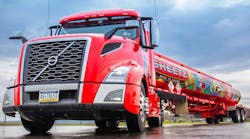

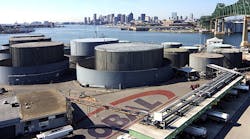
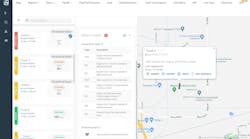





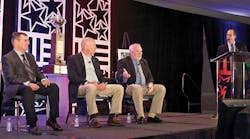
![Harold Sumerford Jr [right], J&M Tank Lines Inc, handed off the National Tank Truck Carriers Inc chairman duties for the 2016-2017 term to Brian Wood, Transwood Inc. Sumerford was the 2015-2016 chairman. Harold Sumerford Jr [right], J&M Tank Lines Inc, handed off the National Tank Truck Carriers Inc chairman duties for the 2016-2017 term to Brian Wood, Transwood Inc. Sumerford was the 2015-2016 chairman.](https://img.bulktransporter.com/files/base/ebm/bulktransporter/image/2019/04/bulktransporter_4017_nttc_annual_convention_2016_0.png?auto=format,compress&fit=crop&q=45&h=139&height=139&w=250&width=250)
